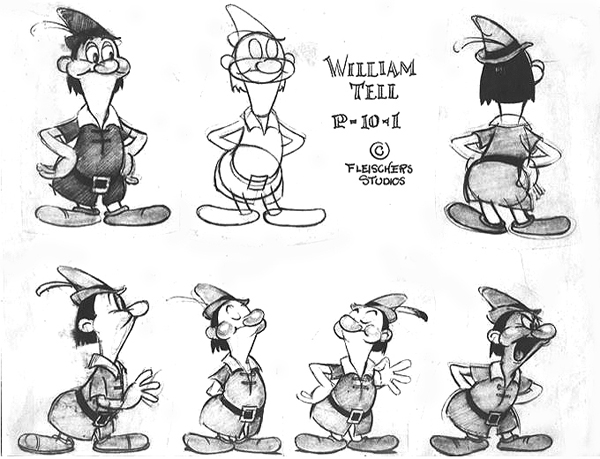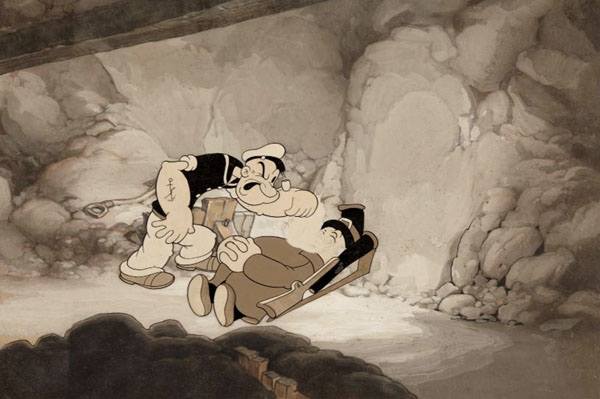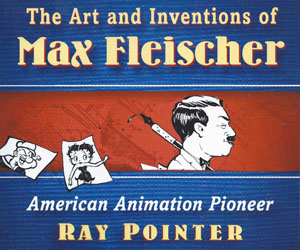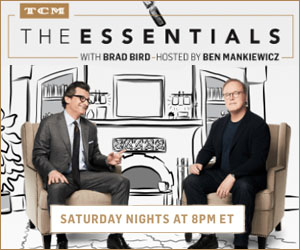
The year 1940 was a major turning point for Fleischer Studios on several levels. BETTY BOOP and SCREEN SONGS had long run their course. And the studio, with Dave Fleischer in charge of production was struggling to find relevancy for the new decade. Trade plants announced a proposed series, SALLY SWING based on the pilot BETTY BOOP cartoon of the same title. But Dave cancelled these plans in favor of the STONE AGE series. A series of one shots emulating Warner cartoons was attempted in the ANIMATED ANTICS series, with a sub series starring supporting characters from GULLIVER’S TRAVELS, Twinkle Toes and The Three Spies. Even a series with GULLIVER’S Gabby was attempted. But its reception was so bad that his series was cancelled after eight entries in spite of being produced in Technicolor.
These new cartoons coming from the Miami Plant were not well received, and theater operators complained, stating that only the Popeye cartoons had box office value. Considering the hits Fleischer Studios had with the two-reel Popeye epic adventures, a return to that format would have seemed to be a good move at this time. And with a staff of over 700 geared for feature production they had the personnel to carry it out.
After exploring the Arabian Knights stories, other heroic tales were considered as Popeye vehicles. But their scope was unfortunately too small. Popeye Meets William Tell, directed by Shamus Culhane had great potential, but was a sadly misguided concept in spite of Culhane’s contributions. In his book, Talking Animals And Other People he recalled:
“Popeye Meets William Tell was a good example of my efforts to take a typical lusty Fleischer Popeye script and superimpose some Hollywood finesse in acting and cutting. The result was something like putting a lace sunbonnet on a wild boar.”

Model Sheet for William Tell (author’s collection).
In spite of Culhane’s good intensions, Popeye Meets William Tell totally misses the fantasy/adventure that could have made this another robust and exciting two-reel Technicolor “Popeye Feature”. Unlike Sindbad and Ali Baba where Popeye was the heroic figure, this one-reel black and white short places him in a silly and embarrassing role, pretending to be William Tell’s son. Imagine the possibilities if it had been played straight as “Popeye Tell.” The obvious casting would place Swee’ Pea as his “son,” and Bluto as the evil Governor. The supporting characters could have been cast as well. But the main problem is that the Culhane version contains no real sense of threat or motivated revenge that was the root of the best Popeye cartoons.
In the original story, William Tell was a Swiss peasant from Bürglen who was known as a skilled Crossbowman. And because he opposed Austrian authority–an interesting parallel between the story and the Fleischer’s ancestral background, he was forced to shoot an apple from his son’s head. Hitting his target in true Robin Hood style, Tell vowed that his next target would be the Governor. Tell was arrested for making this threat, saved the Governor’s life en route to prison, escaped, then killed the Governor in an ambush, leading to the Swiss uprising against Austrian rule. Since the issue of death would have been out of character for Popeye, the reversal of imprisonment would have been the desired solution, with Popeye Tell appointed Governor by the people with a satisfying heroic ending. This solution would have also reflected Max Fleischer’s philosophy about rehabilitation over execution. William Tell would have made for great entertainment worthy of the Popeye formula. Instead Culhane and crew went for comedy in the worst way, mocking the character and the story as if just “going through the motions.”

Original Rip Van Winkle cel over mismatched background from “Stealin’ Ain’t Nice” (Fleischer Studios).
Popeye Meets Rip Van Winkle, directed by Myron Waldman is another missed opportunity for a great adventure cartoon and is more uncomfortable than funny. Film Daily offered a very frank review.
“Popeye Meets Rip Van Winkle”
Paramount 7 mins. Just Fair
Popeye meets up with Rip Van Winkle just as the old gent is being dispossessed for 20 years non-payment of rent in this fair cartoon. He takes Rip home to finish the famous nap but, after a round of wild adventures with a gang of dwarfs, the old man accuses the sailor of robbery and blazes away with his musket.
The original Washington Irving story offered greater opportunities. And the logical choice would be casting Poopdeck Pappy in the role of Rip Van Winkle with Popeye as his son. The Irving story has Van Winkle walking out on his nagging wife, headed for the woods when a thunderstorm starts. He then comes across a group of gnomes seriously engaged in a game of nine pins bowling, which is the source of the thunder. The gnomes offer him some of their “homemade brew,” which causes him to sleep for 20 years. During Van Winkle’s sleep, the American Revolution occurs. When he wakes up, he is unaware of the passage of time, although his beard has grown extremely long. Van Winkle returns to the village and doesn’t know anyone and they don’t recognize him. The villagers become concerned about this stranger and alert the authorities after Van Winkle innocently declares his allegiance to King George. He is then arrested for treason and insanity.
His son, Rip Van Winkle II returns home from the Revolution to his wife and son (played by Olive and Swee’ Pea). Van Winkle II hears of the eccentric old man and realizes he is his father who disappeared 20 years before. This gives Popeye a big heroic rescue sequence leading to the resolution of the confused issues based on an innocent misunderstanding.
While this plot is fairly similar to the original comic strip adventure, The Quest for Poopdeck Pappy and its condensed version in the classic short, Goonland (1938), the Rip Van Winkle story offered far better situations. Instead, a routine and passable vehicle was produced that is not as remembered as the earlier adventure-themed cartoons.
The Quest for Poopdeck Pappy comic strip serial might have been another prospect for a two-reel Special. Even though it had been adapted in Goonland, an expanded version would have been a good choice since Fleischer Studios had already reworked A Dream Walking (1934) as Nix on Hipnotricks (1941). Of course, we all know that Goonland was remade by Famous Studios as the Technicolor short, Popeye’s Pappy (1952).
It is difficult to completely understand what may have influenced decisions that were made years before we were all born. While these proposals seemed to be the logical direction to take at a time when Fleischer Studios was struggling. It is apparent that Fleischer Studios lost the wind in its sails once they moved to Miami. In the process, they seemed headed “off course.” And with Dave Fleischer at the helm, the ship was run aground.
Max, who was in charge of business matters may have been too passive and accommodating with Paramount, conforming to their annual order of 12 black and white Popeye cartoons budgeted at $16,500 each. Why more Popeye Specials were not produced might have been based on their fears over their financial difficulties following the completion of Gulliver’s Travels. But Popeye continued to be lucrative for Paramount, and they continued to order a slate of 12 black and white cartoons. A smarter move at this point might have been a proposal from Max to produce 10 black and white shorts and one two-reeler per year. It is always so easy to reason what should have happened based on hindsight. But we have no idea of what underlying issues that contributed to the atmosphere of malaise that had crept over the studio. In spite of what could have or should have happened, it just did not.
Excerpted and adapted from The Art and Inventions of Max Fleischer: American Animation Pioneer (2017) by Ray Pointer


 Ray Pointer is a filmmaker, animator, historian and author. A film producer for the U.S. Navy, he has worked in the animation industry at such studios as Film Roman, Hanna Barbera, Fred Wolf Films, MGM and Nickelodeon. He has produced a line of classic animation anthologies on DVD and blu-ray for his own company
Ray Pointer is a filmmaker, animator, historian and author. A film producer for the U.S. Navy, he has worked in the animation industry at such studios as Film Roman, Hanna Barbera, Fred Wolf Films, MGM and Nickelodeon. He has produced a line of classic animation anthologies on DVD and blu-ray for his own company 

































So Rossini’s opera “William Tell” is seldom produced because it’s too long, but Fleischer’s “William Tell” might have been better had it been longer….
That’s a very cogent analysis of what’s wrong with those two cartoons, and what might have solved the problems. I love the Popeye two-reelers, and a retelling of the Tell legend in that format could have been another classic. I can see Wimpy as Melchthal and Olive as Tell’s wife Hedwige, with some good-looking young couple as Arnold and Mathilde (Fearless Fred and Sally Swing?). In 1940, the legend’s message of standing up against oppression would have resonated well with the political situation in Europe at the time.
As for the “underlying issues that contributed to the atmosphere of malaise that had crept over the studio”, probably the foremost of them was that by 1940, Max and Dave Fleischer were no longer speaking to each other. According to Richard Fleischer’s OUT OF THE INKWELL (2005), after the move to Miami Dave’s gambling had gotten out of hand, and he was having an open affair with his secretary, which Max considered unforgivable. When Max refused to let Dave write the songs to “Gulliver’s Travels”, Dave considered it a personal betrayal. After Paramount took over the studio, the brothers never saw or spoke to each other again, and for the rest of their lives (they both lived into the 1970s) they only communicated through intermediaries. The wonder is not that the studio had problems, but that it carried on as well as it did during this period.
I cover the underlying issues between Max and Dave that went back to the period of the Strike and only manifested itself once in Miami. The “malaise” certainly crept over the crew since the spirit had died. But the studio seemed to experience rebirth once it changed hands. Oddly, the same story men and key Directors remained, and the gloomy atmosphere due to the problems between Max and Dave had disappeared.
In the TV series “The Famous Adventures of Mr. Magoo,” there was a “William Tell” segment in which Magoo was cast in the role of Tell. Despite the use of Magoo as the main character and the cartoony design of the characters, the story was played fairly straight, aside from the antics of the goat. Also there was an episode of “Rip Van Winkle” which hews fairly closely to the Washington Irving original. When teaching the original story in my English classes, I would often refer to the Magoo version of “Rip Van Winkle” as an example of a film adaptation that remained true to its source. One of the layout designers who had worked on the “Famous Adventures” series showed me copies of the original model sheets used for those episodes, as well as several others.
Where the Fleischer’s really missed the boat (so to speak) on the color two-reeler options was in not using Elzie’s Segar’s Sea Hag from the Thimble Theater cast of characters. It would have been right up the alley for WIllard Bowsky, who loved putting a certain sense of menace even into some of his routine B&W cartoons. Paramount would finally animate her for the KFS Popeyes in the early 1960s, but the far shorter stories and highly-limited TV budgets meant they were never able to take advantage of the narrative potentials and darker themes the Fleischer Studio could manage.
Yes, I made that suggestion in my book, using The Sea Hag as a Bluto substitute after the loss of Gus Wickie, the remembered voice of Bluto before Jackson Beck took over the role in 1944. One of my suggestions was to have cast The Sea Hang in the role of the Sorcerer in ALADDIN since she would have been a far more effective representation of evil than what they went with.
J Lee makes a very good point. Segar’s “The Mystery Melody” story had great possibilities as a Popeye “special” — heck, it still does.
I’ve felt for a long time that the success of the Technicolor two-reelers could have shown the Fleischers that that they had a real opportunity to not have to go head-to-head with Disney, but to carve out a “niche market” where nobody else was competing with them, and to continue doing what they did best in their own distinctive way that wasn’t imitative of anyone else.
Yes and no in several respects. As I detail in my book, the primary motivation for competing in the animated feature arena with Disney came from Paramount Head, Barney Balaban. Although Max had been petitioning Paramount as early as 1934 about producing animated features, it was not until the success of Disney’s SNOW WHITE that Paramount was convinced that this would be a lucrative market. But much of Disney’s success in this, aside from preparing for the nuances in feature animation was that his product was solely focused on production animated films. So his marketing was channeled in that direction. Paramount had a large slate of motion pictures in production and distribution. They did not seem to know how to market animated features in the way Disney did, even though they made the commercial effort. with radio spots and record releases and licensing of the songs for other artists. But their ancillary merchandising was not as high in quality as Disney’s.
At this point in time, it is easy to say what should have been based on what we can see as the whole. But at the time, it appears there was a feeling of being overwhelmed and no clear vision of where to go to reach the next level. So they ran in circles, playing is safe instead of moving ahead as you would think they could have.
Disney, Warner, and MGM all released official all-cartoon programs. The MGM feature “Tom and Jerry’s Festival of Fun” was evidently the first to cobble shorts together with a framing story; later Disney and Warner would use that approach for television product, and Disney finally applied it to the Winnie the Pooh featurettes for theatrical release.
Did Fleischer (or Paramount) every consider packaging Popeye’s three specials together, either “as is” or with a framing story? They could easily have reworked Olive’s screenwriting bit from “Aladdin” into a frame for all three Arabian Nights, possibly without any new animation at all. Teamed with a Color Rhapsody or two it would be a viable feature attraction.
For that matter, did any exhibitors book the specials together, with or without distributor encouragement?
No, it appears that there was no thought of packaging the three Specials. The Arabian Knights themes would have been a clever means of re-packaging them. But Paramount was not focused in this area and only seemed to look at the cartoons as an added attraction instead of a major component on their program, even though POPEYE was their most valuable Short Subject.
GOONLAND was remade yet again by Paramount for King Features 1960-’62 Popeye TV series under the title
Me Quest For Poopdeck Pappy
To a degree, GOONLAND was remade in 1952 as POPEYE’S PAPPY. But the King Features production was truer to the original strip story. As I suggested, this would have been an ideal story for a longer format POPEYE Special. But alas, the “fire” was dying at Fleischer Studios in the 1940s.
The Rip Van Winkle short has probably the most anticlimactic spinach buff ever. He eats spinach, grows back to normal, and just carries the old man away like a coward.
Looking at the title, I was expecting to hear about Popeye films planned but never finished.
The title states exactly what the article promises. Perhaps you were drawn into it anyway. But did you enjoy the article? THAT is the point.
It’s too bad that “Popeye Meets Rip Van Winkle”wasn’t done in a more entertaining and inventing style..”Poopdeck Pappy”would have been perfect for that character. Still..there is a trace of”Poopdeck Pappy”in that cartoon? I recall the voice of “Rip”(which is used at the end of the film..where he accuses “Popeye”of being a pickpocket..not a robber)sounds just like The younger sailor’s trouble making dad.
Unlike many of the people contributing knowledge here I am not an animation researcher/producer/compiler/author, etc. I’m just another one of those people who grew up watching many of these old productions from cinema’s early days as “Afternoon Filler for Kids” on the local TV stations in the Boston metropolitan area. Having stated this, it doesn’t mean that I haven’t done a bit of “Fan Research” on these wonderful, animated and otherwise, films.
Perhaps the reason that the “Two-Reeler” entries was not used further was because of the second wave of the Great Depression, c. 1936-7, made theater owners realize that in order to entice customers back to their establishments was to give them more bang for their buck. Hence, they began to offer “Double-Features” for the same price as a single full-length movie. This meant that they had to trim some of the existing content to make room for the second feature on the bill. This is when all two-reelers began to be faded out. Previously you would see a news reel, a cartoon, previews of coming attractions, a two-reeler and the feature film itself. By this time Hal Roach had sold all of his two-reel subjects to MGM, or ceased production of them, and concentrated on features, for example.
In the book “Moe Howard and the Three Stooges” Moe makes mention that they started out getting $50,000.00 a year from Columbia and were still making the same amount over twenty years later, all the while being told by Columbia management that “Two-reelers are fading in popularity. Theater goers aren’t interested in them anymore.”.
A good example of an ‘Inside Joke’ in relation to this change is in the 1942 Three Stooges short “Loco-Boy Makes Good”. The Stooges are trying to help an elderly lady, who is about to be evicted from the hotel that she owns, by turning it into a popular night spot. In one scene they tell her to relax and go see a movie while they prepare the hotel for its transformation. When she is told to see a movie, Curley adds the polite admonition “Single Feature!”. As I kid, I thought that this was merely a suggestion to be frugal. As it turns out it was meant to encourage theater goers to continue to support theaters which exhibited two-reelers, as they now were often removed from double feature bills.